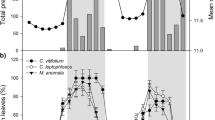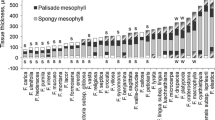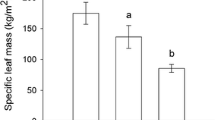Abstract
Uncertainty still exists on the directions and intensity of changes in leaf herbivory under scenarios of global warming. We, therefore, conducted an investigation on insect herbivory along an elevational gradient to explore how leaf herbivory may respond to future climate warming using a space-for-time substitution approach. We hypothesize that the leaf herbivory for alpine woody species should decline with elevation. We also guess the leaf herbivory may not differ between different leaf-age groups, for the old leaves are less attractive to insect due to their lower nutrients. To approve these assertions, we measured different aspects of leaf herbivory, i.e., the intensity (leaf area consumed per damaged leaf), frequency (percentage of leaves damaged), and rate (percentage of consumed leaf area over the total number of leaves), across different leaf-age groups for Rhododendron aganniphum var. schizopeplum along an elevational gradient (4280–4640 m) in the Sergymla Mountains, southeast Tibet. Related leaf traits of leaf mass per area (LMA) and nitrogen (Nmass), as well as total phenolics for 1-year-old leaves, were also investigated. In contrast with our expectation, the rate of herbivory did not vary with elevation, while the frequency and intensity reflected increasing and declining patterns, respectively. LMA and total phenolics tended to increase with elevation, while Nmass significantly declined. Further analysis indicated that Nmass and total phenolics mainly explained the variation of frequency of herbivory, while Nmass reflected a significant effect on the variation of intensity. No differences in herbivory were found between the leaf-age groups. Our results suggest that the lower intensity of leaf herbivory at higher elevations is mainly associated with the declined nutritional levels, while the higher frequency might be related to the higher costly anti-herbivore defenses like phenolics and the lower nutritional levels. Although the older leaves are exposed to herbivore attacks for a longer time, they possessed the same herbivory levels as current-year leaves partly due to their lower nitrogen concentrations. Both supporting the nutrient limitation hypothesis, i.e., plants with lower leaf nutrient levels possess less leaf herbivory. In all, the herbivory on the alpine Rhododendron is small in magnitude, but given the higher herbivory (for intensity at least) under persistent warming conditions and its potential impacts on mediating plant–insect interactions, insect herbivory should be included in predictions of climate change impacts on alpine ecosystems.


Similar content being viewed by others
Data availability
All data needed to evaluate the conclusions in the paper are present in the paper. Additional data related to this paper may be requested from the authors.
Code availability
Not applicable.
References
Abdala-Roberts L, Rasmann S, Bern y-Miery Teran JC, Covelo F, Glauser G, Moreira X (2016) Biotic and abiotic factors associated with altitudinal variation in plant traits and herbivory in a dominant oak species. Am J Bot 103(12):2070–2078. https://doi.org/10.3732/ajb.1600310
Aerts R (1996) Nutrient resorption from senescing leaves of perennials: are there general patterns? J Ecol 84(4):597–608. https://doi.org/10.2307/2261481
Agrawal AA (2007) Macroevolution of plant defense strategies. Trends Ecol Evol 22(2):103–109. https://doi.org/10.1016/j.tree.2006.10.012
Agrawal AA (2011) Current trends in the evolutionary ecology of plant defence. Funct Ecol 25(2):420–432. https://doi.org/10.1111/j.1365-2435.2010.01796.x
Ainsworth EA, Gillespie KM (2007) Estimation of total phenolic content and other oxidation substrates in plant tissues using Folin–Ciocalteu reagent. Nat Protoc 2(4):875–877. https://doi.org/10.1038/nprot.2007.102
Altmann SH, Claros S (2015) Insect abundance and damage on the deciduous Nothofagus macrocarpa increase with altitude at a site in the Mediterranean climate zone of Chile. Austral Entomol 54(4):402–410. https://doi.org/10.1111/aen.12142
Ayres MP, MaJ L (2000) Assessing the consequences of global change for forest disturbance from herbivores and pathogens. Sci Total Environ 262(3):263–286. https://doi.org/10.1016/S0048-9697(00)00528-3
Bale JS, Masters GJ, Hodkinson ID, Awmack C, Bezemer TM, Brown VK, Butterfield J, Buse A, Coulson JC, Farrar J, Good JEG, Harrington R, Hartley S, Jones TH, Lindroth RL, Press MC, Symrnioudis I, Watt AD, Whittaker JB (2002) Herbivory in global climate change research: direct effects of rising temperature on insect herbivores. Glob Change Biol 8(1):1–16. https://doi.org/10.1046/j.1365-2486.2002.00451.x
Barrio IC, Bueno CG, Hik DS (2016a) Warming the tundra: reciprocal responses of invertebrate herbivores and plants. Oikos 125(1):20–28. https://doi.org/10.1111/oik.02190
Barrio IC, Hik DS, Jonsdottir IS, Bueno CG, Morsdorf MA, Ravolainen VT (2016b) Herbivory Network: an international, collaborative effort to study herbivory in Arctic and alpine ecosystems. Polar Sci 10(3):297–302. https://doi.org/10.1016/j.polar.2016.03.001
Barrio IC, Linden E, Te Beest M, Olofsson J, Rocha A, Soininen EM, Alatalo JM, Andersson T, Asmus A, Boike J, Brathen KA, Bryant JP, Buchwal A, Bueno CG, Christie KS, Denisova YV, Egelkraut D, Ehrich D, Fishback L, Forbes BC, Gartzia M, Grogan P, Hallinger M, Heijmans M, Hik DS, Hofgaard A, Holmgren M, Hoye TT, Huebner DC, Jonsdottir IS, Kaarlejarvi E, Kumpula T, Lange C, Lange J, Levesque E, Limpens J, Macias-Fauria M, Myers-Smith I, van Nieukerken EJ, Normand S, Post ES, Schmidt NM, Sitters J, Skoracka A, Sokolov A, Sokolova N, Speed JDM, Street LE, Sundqvist MK, Suominen O, Tananaev N, Tremblay JP, Urbanowicz C, Uvarov SA, Watts D, Wilmking M, Wookey PA, Zimmermann HH, Zverev V, Kozlov MV (2017) Background invertebrate herbivory on dwarf birch (Betula glandulosa-nana complex) increases with temperature and precipitation across the tundra biome. Polar Biol 40(11):2265–2278. https://doi.org/10.1007/s00300-017-2139-7
Barton KE, Edwards KF, Koricheva J (2019) Shifts in woody plant defence syndromes during leaf development. Funct Ecol 33(11):2095–2104. https://doi.org/10.1111/1365-2435.13435
Baskett CA, Schemske DW (2018) Latitudinal patterns of herbivore pressure in a temperate herb support the biotic interactions hypothesis. Ecol Lett 21(4):578–587. https://doi.org/10.1111/ele.12925
Benevenuto RF, Seldal T, Polashock J, Moe SR, Rodriguez-Saona C, Gillespie MAK, Hegland SJ (2020) Molecular and ecological plant defense responses along an elevational gradient in a boreal ecosystem. Ecol Evol 10(5):2478–2491. https://doi.org/10.1002/ece3.6074
Birkemoe T, Bergmann S, Hasle TE, Klanderud K (2016) Experimental warming increases herbivory by leaf-chewing insects in an alpine plant community. Ecol Evol 6(19):6955–6962. https://doi.org/10.1002/ece3.2398
Buckley J, Widmer A, Mescher MC, De Moraes CM (2019) Variation in growth and defence traits among plant populations at different elevations: implications for adaptation to climate change. J Ecol 107(5):2478–2492. https://doi.org/10.1111/1365-2745.13171
Campbell WR, Hanna MI (1937) The determination of nitrogen by modified Kjeldahl methods. J Biol Chem 119(1):1–7
Coley PD, Barone JA (1996) Herbivory and plant defenses in tropical forests. Annu Rev Ecol Syst 27:305–335. https://doi.org/10.1146/annurev.ecolsys.27.1.305
Conrad KF, Woiwod IP, Parsons M, Fox R, Warren MS (2004) Long-term population trends in widespread British moths. J Insect Conserv 8(2–3):119–136
DeLucia EH, Nabity PD, Zavala JA, Berenbaum MR (2012) Climate change: resetting plant-insect interactions. Plant Physiol 160(4):1677–1685. https://doi.org/10.1104/pp.112.204750
English-Loeb GM, Karban R (1992) Consequences of variation in flowering phenology for seed head herbivory and reproductive success in Erigeron glaucus (Compositae). Oecologia 89(4):588–595. https://doi.org/10.1007/BF00317168
Ewers FW, Schmid R (1981) Longevity of needle fascicles of Pinus longaeva (Bristlecone pine) and other North American pines. Oecologia 51:107–115
Fernández Honaine M, Montti L, Qi W, Osterrieth M (2019) Anatomical traits, silica content and herbivory damage in leaves of invasive tree Ligustrum lucidum developed in novel and native ranges. Flora. https://doi.org/10.1016/j.flora.2019.151447
Galen C (1990) Limits to the distributions of alpine tundra plants: herbivores and the alpine skypilot, Polemonium Viscosum. Oikos 59(3):355–358. https://doi.org/10.2307/3545146
Galman A, Abdala-Roberts L, Zhang S, Berny-Mier y Teran JC, Rasmann S, Moreira X (2018) A global analysis of elevational gradients in leaf herbivory and its underlying drivers: effects of plant growth form, leaf habit and climatic correlates. J Ecol 106(1):413–421. https://doi.org/10.1111/1365-2745.12866
Garibaldi LA, Kitzberger T, Chaneton EJ (2011) Environmental and genetic control of insect abundance and herbivory along a forest elevational gradient. Oecologia 167(1):117–129. https://doi.org/10.1007/s00442-011-1978-0
Gherlenda AN, Moore BD, Haigh AM, Johnson SN, Riegler M (2016) Insect herbivory in a mature Eucalyptus woodland canopy depends on leaf phenology but not CO2 enrichment. BMC Ecol 16:47. https://doi.org/10.1186/s12898-016-0102-z
Güsewell S (2005) Nutrient resorption of wetlands graminoids is related to the type of nutrient limitation. Funct Ecol 19(2):344–354. https://doi.org/10.1111/j.0269-8463.2005.00967.x
IPCC (2013) Climate change 2013: the physical science basis. Cambridge University Press, Cambridge
Kessler A, Heil M (2011) The multiple faces of indirect defences and their agents of natural selection. Funct Ecol 25(2):348–357. https://doi.org/10.1111/j.1365-2435.2010.01818.x
Kong GQ, Luo TX, Liu XS, Zhang L, Liang EY (2012) Annual ring widths are good predictors of changes in net primary productivity of alpine Rhododendron shrubs in the Sergyemla Mountains, southeast Tibet. Plant Ecol 213(11):1843–1855. https://doi.org/10.1007/s11258-012-0140-3
Körner C (2007) The use of “altitude” in ecological research. Trends Ecol Evol 22(11):569–574. https://doi.org/10.1016/j.tree.2007.09.006
Kozlov MV, Zvereva EL (2015) Changes in the background losses of woody plant foliage to insects during the past 60 years: are the predictions fulfilled? Biol Lett 11(7):20150480. https://doi.org/10.1098/rsbl.2015.0480
Kozlov MV, Zvereva EL (2018) Background insect herbivory: impacts, patterns and methodology. In: Cánovas FM, Lüttge U, Matyssek R (eds) Progress in botany, vol 79. Springer International Publishing, Cham, pp 313–355
Kozlov MV, Stekolshchikov AV, Söderman G, Labina ES, Zverev V, Zvereva EL (2015a) Sap-feeding insects on forest trees along latitudinal gradients in northern Europe: a climate-driven patterns. Glob Change Biol 21(1):106–116. https://doi.org/10.1111/gcb.12682
Kozlov MV, Lanta V, Zverev V, Zvereva EL (2015b) Global patterns in background losses of woody plant foliage to insects. Glob Ecol Biogeogr 24(10):1126–1135. https://doi.org/10.1111/geb.12347
Kozlov MV, Lanta V, Zverev V, Zvereva EL (2015c) Background losses of woody plant foliage to insects show variable relationships with plant functional traits across the globe. J Ecol 103(6):1519–1528. https://doi.org/10.1111/1365-2745.12471
Kozlov MV, Lanta V, Zverev V, Rainio K, Kunavin MA, Zvereva EL (2017) Decreased losses of woody plant foliage to insects in large urban areas are explained by bird predation. Glob Change Biol 23:4354–4364
Lehmann P, Ammunét T, Barton M, Battisti A, Eigenbrode SD, Jepsen JU, Kalinkat G, Neuvonen S, Niemelä P, Terblanche JS, Økland B, Björkman C (2020) Complex responses of global insect pests to climate warming. Front Ecol Environ 18(3):141–149. https://doi.org/10.1002/fee.2160
Liang EY, Shao XM, Xu Y (2009) Tree-ring evidence of recent abnormal warming on the southeast Tibetan Plateau. Theor Appl Climatol 98(1–2):9–18. https://doi.org/10.1007/s00704-008-0085-6
Liu XS, Luo TX (2011) Spatiotemporal variability of soil temperature and moisture across two contrasting timberline ecotones in the Sergyemla Mountains, Southeast Tibet. Arct Antarct Alp Res 43(2):229–238. https://doi.org/10.1657/1938-4246-43.2.229
Liu Z, Jing J, Li K, Cai Y (2013) Insect herbivory characteristic on leaves of plant species in the evergreen broadleaved forests. Ecol Environ Sci 22(1):78–84
Mithöfer A, Boland W (2012) Plant defence against herbivores: chemical aspects. Annu Rev Plant Biol 63:431–450. https://doi.org/10.1146/annurev-arplant-042110-103854
Moreira X, Petry WK, Mooney KA, Rasmann S, Abdala-Roberts L (2018a) Elevational gradients in plant defences and insect herbivory: recent advances in the field and prospects for future research. Ecography 41(9):1485–1496. https://doi.org/10.1111/ecog.03184
Moreira X, Castagneyrol B, Abdala-Roberts L, Teran JCB-M, Timmermans BGH, Bruun HH, Covelo F, Glauser G, Rasmann S, Tack AJM (2018b) Latitudinal variation in plant chemical defences drives latitudinal patterns of leaf herbivory. Ecography 41(7):1124–1134. https://doi.org/10.1111/ecog.03326
Njovu HK, Peters MK, Costa DS, Brandl R, Kleyer M, Steffan-Dewenter I (2019) Leaf traits mediate changes in invertebrate herbivory along broad environmental gradients on Mt. Kilimanjaro, Tanzania. J Anim Ecol 88(11):1777–1788. https://doi.org/10.1111/1365-2656.13058
Onoda Y, Westoby M, Adler PB, Choong AMF, Clissold FJ, Cornelissen JHC, Díaz S, Dominy NJ, Elgart A, Enrico L, Fine PVA, Howard JJ, Jalili A, Kitajima K, Kurokawa H, McArthur C, Lucas PW, Markesteijn L, Pérez-Harguindeguy N, Poorter L, Richards L, Santiago LS, Sosinski EE Jr, Van Bael SA, Warton DI, Wright IJ, Joseph Wright S, Yamashita N (2011) Global patterns of leaf mechanical properties. Ecol Lett 14(3):301–312. https://doi.org/10.1111/j.1461-0248.2010.01582.x
Parmesan C, Ryrholm N, Stefanescu C, Hill JK, Thomas CD, Descimon H, Huntley B, Kaila L, Kullberg J, Tammaru T, Tennent WJ, Thomas JA, Warren M (1999) Poleward shifts in geographical ranges of butterfly species associated with regional warming. Nature 399(6736):579–583. https://doi.org/10.1038/21181
Pellissier L, Roger A, Bilat J, Rasmann S (2014) High elevation Plantago lanceolata plants are less resistant to herbivory than their low elevation conspecifics: is it just temperature? Ecography 37(10):950–959. https://doi.org/10.1111/ecog.00833
Pellissier L, Moreira X, Danner H, Serrano M, Salamin N, van Dam NM, Rasmann S (2016) The simultaneous inducibility of phytochemicals related to plant direct and indirect defences against herbivores is stronger at low elevation. J Ecol 104(4):1116–1125. https://doi.org/10.1111/1365-2745.12580
Poorter H, Niinemets Ü, Poorter L, Wright IJ, Villar R (2009) Causes and consequences of variation in leaf mass per area (LMA): a meta-analysis. New Phytol 182:565–588
Pöyry J, Leinonen R, Söderman G, Nieminen M, Heikkinen RK, Carter TR (2011) Climate-induced increase of moth multivoltinism in boreal regions. Glob Ecol Biogeogr 20:289–298. https://doi.org/10.1111/j.1466-8238.2010.00597.x
Rasmann S, Pellissier L, Defossez E, Jactel H, Kunstler G (2014a) Climate-driven change in plant-insect interactions along elevation gradients. Funct Ecol 28(1):46–54. https://doi.org/10.1111/1365-2435.12135
Rasmann S, Buri A, Gallot-Lavallée M, Joaquim J, Purcell J, Pellissier L (2014b) Differential allocation and deployment of direct and indirect defences by Vicia sepium along elevation gradients. J Ecol 102(4):930–938. https://doi.org/10.1111/1365-2745.12253
Rheubottom SI, Barrio IC, Kozlov MV, Alatalo JM, Andersson T, Asmus AL, Baubin C, Brearley FQ, Egelkraut DD, Ehrich D, Gauthier G, Jónsdóttir IS, Konieczka S, Lévesque E, Olofsson J, Prevéy JS, Slevan-Tremblay G, Sokolov A, Sokolova N, Sokovnina S, Speed JDM, Suominen O, Zverev V, Hik DS (2019) Hiding in the background: community-level patterns in invertebrate herbivory across the tundra biome. Polar Biol 42(10):1881–1897. https://doi.org/10.1007/s00300-019-02568-3
Sam K, Koane B, Sam L, Mrazova A, Segar S, Volf M, Moos M, Simek P, Sisol M, Novotny V (2020) Insect herbivory and herbivores of Ficus species along a rain forest elevational gradient in Papua New Guinea. Biotropica 52(2):263–276. https://doi.org/10.1111/btp.12741
Scott-Brown AS, Gregory T, Farrell IW, Stevenson PC (2016) Leaf trichomes and foliar chemistry mediate defence against glasshouse thrips; Heliothrips haemorrhoidalis (Bouche) in Rhododendron simsii. Funct Plant Biol 43(12):1170–1182. https://doi.org/10.1071/FP16045
Wang YF, Li XX, Dawadi B, Eckstein D, Liang EY (2013) Phenological variation in height growth and needle unfolding of Smith fir along an altitudinal gradient on the southeastern Tibetan Plateau. Trees 27(2):401–407. https://doi.org/10.1007/s00468-012-0793-5
Wang XF, Liu JF, Gao WQ, Deng YP, Ni YY, Xiao YH, Kang FF, Wang Q, Lei JP, Jiang ZP (2016) Defense pattern of Chinese cork oak across latitudinal gradients: influences of ontogeny, herbivory, climate and soil nutrients. Sci Rep 6:27269. https://doi.org/10.1038/srep27269
Wolf A, Kozlov MV, Callaghan TV (2008) Impact of non-outbreak insect damage on vegetation in northern Europe will be greater than expected during a changing climate. Clim Change 87:91–106
Yang DQ, Ishida S, Goodison BE, Gunther T (1999) Bias correction of daily precipitation measurements for Greenland. J Geophys Res 105(D6):6171–6182. https://doi.org/10.1029/1998JD200110
Zhang S, Zhang YX, Ma KM (2015) Mutualism with aphids affects the trophic position, abundance of ants and herbivory along an elevational gradient. Ecosphere 6(12):1–11. https://doi.org/10.1890/ES15-00229.1
Zhang L, Yang L, Shen W (2020) Dramatic altitudinal variations in leaf mass per area of two plant growth forms at extreme heights. Ecol Indic 110:105890. https://doi.org/10.1016/j.ecolind.2019.105890
Acknowledgements
We are grateful to the staff in Southeast Tibet Observation and Research Station for the Alpine Environment of CAS for the field work. This research is funded by the Second Tibetan Plateau Scientific Expedition and Research (STEP) program (2019QZKK0301-1), the S&T Basic Work of Sciences and Technology (2015FY11030001-5) and the National Natural Science Foundation of China (41471039).
Funding
This research is funded by the Second Tibetan Plateau Scientific Expedition and Research (STEP) program (2019QZKK0301-1), the S&T Basic Work of Sciences and Technology (2015FY11030001-5) and the National Natural Science Foundation of China (41471039).
Author information
Authors and Affiliations
Contributions
LZ and EL designed the study, LZ, GC, WS and YG collected the samples and measured the leaf traits. All authors contributed to data analysis, interpretation and writing.
Corresponding author
Ethics declarations
Conflict of interest
This manuscript has not been published before and is not being considered for publication elsewhere. All authors have contributed to the creation of this manuscript for important intellectual content and read and approved the final manuscript. We declare there is no conflict of interest.
Ethics approval
This study does not involve research on human participants or animals.
Informed consent
Informed consent was obtained from all individual participants included in the study.
Additional information
Publisher's Note
Springer Nature remains neutral with regard to jurisdictional claims in published maps and institutional affiliations.
Supplementary Information
Below is the link to the electronic supplementary material.
Rights and permissions
About this article
Cite this article
Cui, G., Zhang, L., Shen, W. et al. Intensity, frequency and rate of insect herbivory for an alpine Rhododendron shrub: elevational patterns and leaf-age effects. Alp Botany 132, 233–243 (2022). https://doi.org/10.1007/s00035-021-00274-7
Received:
Accepted:
Published:
Issue Date:
DOI: https://doi.org/10.1007/s00035-021-00274-7




